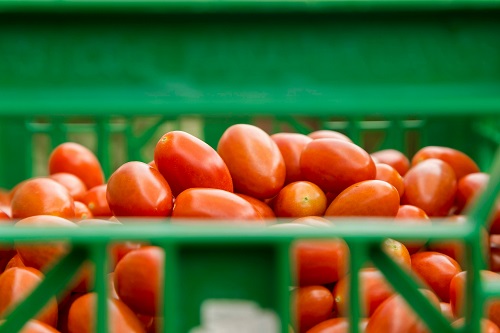Tomato Farming

Title: Tomato Farming.
Type: Agricultural Production.
Key Products for Sale:
Fresh Tomatoes: Varieties including beefsteak, cherry, roma, and heirloom.
Tomato Seeds: High-quality seeds for home gardeners and other farmers.
Value-added Products: Sun-dried tomatoes, tomato sauce, salsa, and canned tomatoes.
Technology Considerations:
Drip Irrigation Systems: Efficient water management for optimal tomato growth.
Greenhouse Technology: Controlled environment for year-round production and protection against adverse weather conditions.
Soil Monitoring Devices: Sensors for monitoring soil moisture, pH levels, and nutrient content.
Mobile Apps for Crop Management: Tools for tracking growth, scheduling irrigation, and managing pest control.
Market for the Products:
Local Consumers: Farmer’s markets, grocery stores, and restaurants.
Wholesale Buyers: Supermarkets, food distributors, and food processing companies.
Export Markets: International buyers interested in high-quality tomatoes and value-added products.
Key Inputs into the Business:
Tomato Seeds: High-quality seeds from reputable suppliers.
Fertilizers and Soil Amendments: Organic and/or conventional fertilizers to enrich soil fertility.
Irrigation Systems: Drip irrigation kits, sprinkler systems, or greenhouse setups.
Labor: Skilled workers for planting, harvesting, and crop maintenance.
Packaging Materials: Containers, crates, and labels for packaging fresh tomatoes and value-added products.
Product Preparation Process:
- Land Preparation: Soil tillage, leveling, and amendment.
- Planting: Sowing tomato seeds or transplanting seedlings into prepared soil.
- Crop Maintenance: Irrigation, fertilization, weed control, and pest management.
- Harvesting: Selective picking of ripe tomatoes at peak flavor and maturity.
- Processing (if applicable): Sun-drying, canning, or sauce-making for value-added products.
- Packaging: Sorting, grading, and packaging tomatoes for sale in fresh or processed forms.
- Distribution: Transporting products to local markets, wholesalers, or export facilities.
Quality Considerations:
Crop Selection: Choosing disease-resistant tomato varieties suitable for local growing conditions.
Soil Health: Implementing sustainable farming practices to maintain soil fertility and health.
Harvesting: Picking tomatoes at optimal ripeness for best flavor and shelf life.
Processing Standards: Adhering to food safety regulations and quality control measures for value-added products.
Cost of Investment:
Land Acquisition or Lease: Varies depending on location and size of the farm.
Greenhouse Construction: KES 500,000 – KES 2,000,000 (depending on size and materials).
Irrigation Systems: KES 200,000 – KES 500,000 (drip irrigation setup for greenhouse).
Seeds and Seedlings: KES 20,000 – KES 50,000 (for initial planting).
Fertilizers and Soil Amendments: KES 30,000 – KES 100,000 (annual cost).
Labor: KES 100,000 – KES 300,000 per year (depending on farm size).
Packaging Materials: KES 20,000 – KES 50,000 (for containers and labels).
Marketing Expenses: KES 50,000 – KES 200,000 per year (including branding and promotion).
Required Operational Infrastructure:
- Tomato Fields or Greenhouses: Growing areas for tomato cultivation.
- Irrigation Systems: Water distribution infrastructure for efficient crop watering.
- Storage Facilities: Cool, dry storage areas for harvested tomatoes.
- Processing Equipment (if applicable): Dehydrators, canning machines, and sauce-making equipment.
- Transportation Vehicles: Trucks or vans for delivering products to market.
Most Suitable or Viable Location of the Business:
- Regions with Favorable Climate: Areas with warm temperatures and sufficient sunlight for tomato growth.
- Access to Water Sources: Proximity to water bodies or reliable irrigation systems.
- Proximity to Markets: Convenient access to local consumers, wholesalers, and export facilities.
Potential Sources of Investment Capital:
- Personal Savings: Self-funding the business with personal savings or investments.
- Agricultural Loans: Securing loans from banks or financial institutions specializing in agriculture.
- Government Grants: Exploring grants and subsidies available for agricultural startups and sustainability initiatives.
- Partnership Opportunities: Collaborating with investors or agricultural organizations for funding and support.
Requirements for Effective Management:
Agricultural Expertise: Knowledgeable farm managers and agronomists with experience in tomato cultivation.
Business Management Skills: Effective leadership, financial management, and strategic planning.
Marketing Strategies: Branding, promotion, and distribution strategies to reach target markets.
Quality Control Measures: Monitoring crop health, processing standards, and product quality.
Customer Relationship Management: Building strong relationships with buyers and consumers.
Role of Mobile Phones and ICT in the Business:
Farm Management Apps: Tools for monitoring crop growth, irrigation scheduling, and pest control.
Market Research: Accessing market information, pricing trends, and consumer preferences.
Online Marketing: Utilizing social media, websites, and e-commerce platforms to promote products and engage customers.
Communication: Facilitating communication with suppliers, buyers, and agricultural experts.
Statutory Regulations and Licenses:
Agricultural Regulations: Compliance with local agricultural laws, crop safety standards, and environmental regulations.
Business Licensing: Obtaining permits and licenses for operating a farm, processing facility, and food business.
Food Safety Standards: Adhering to hygiene practices, labeling requirements, and quality control measures.
Pricing:
Competitive Pricing: Setting prices based on production costs, market demand, and product quality.
Value-added Pricing: Premium pricing for processed tomato products with added value and convenience.
Profitability:
Estimated Annual Profits: Depending on farm size, production volume, and market conditions, profits can range from KES 500,000 to KES 2,000,000 or more.
Profit Margin: Aim for a profit margin of 20-30% by optimizing production efficiency, minimizing costs, and maximizing revenue.
Next Steps to Take:
- Secure Land and Infrastructure: Acquire or lease suitable land and establish the necessary infrastructure for tomato farming.
- Source Inputs and Equipment: Purchase seeds, irrigation systems, and other inputs required for cultivation.
- Implement Crop Management Practices: Follow best practices for soil preparation, planting, and crop maintenance.
- Develop Marketing Strategies: Create a branding and promotion plan to attract buyers and build a market presence.
- Monitor Performance: Track crop growth, sales, and financial metrics to assess business performance and make informed decisions.
- Expand and Diversify: Explore opportunities for expanding product offerings, entering new markets, or integrating vertical operations to enhance profitability and sustainability.


Tomatoes farming is a popular and profitable agriculture activities because tomatoes are widely consumed around the world, successful tomato farming requires well drained soil, adequate sunlight and consistent watering